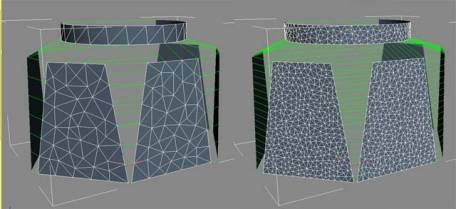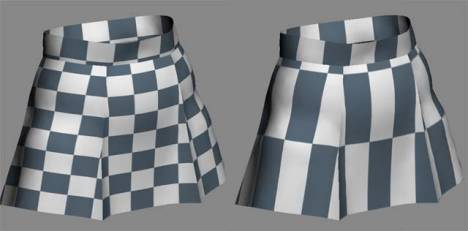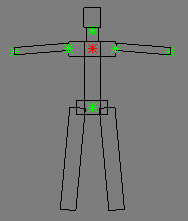The Main Parameters rollout is the first rollout you see on the Modify panel once you apply the Garment Maker modifier.
This rollout comprises mostly controls to create and adjust the mesh. The remaining rollouts are available at the sub-object levels.

Adjusts the relative density of the mesh (in other words, the number of triangles per unit area). Possible values range between 0.01 and 10.0. A value of 10.0 creates a very dense mesh, while 0.01 creates a comparatively low-resolution mesh.
For best results, use the lowest possible density to achieve the desired result. This speeds up simulation time and overall performance.

Left: Density=0.5
Right: Density=1.5
When on, Garment Maker updates the mesh automatically if you change the density or add/remove seams.
This setting is active at all sub-object levels, so it's recommended you leave it on to see changes as you make them. The only time you might want to turn off Auto Mesh is while creating the seams at the Curves sub-object level. Re-meshing can take some time, so you might want to define a number of seams before re-meshing.
The following setting, comprising three radio buttons, determines how the cloth panels are passed up the modifier stack to the Cloth modifier:
When on, the UV coordinates are based on the square bounding rectangle whose edge is the longer edge of the actual bounding box, and so have an aspect ratio of 1:1. When off, the UV coordinates do not maintain a 1:1 apect ratio but use the actual bounding box.

Left: Stretch Map Coords on
Right: Stretch Map Coords off
Use these controls to specify locations for each panel on the figure to be clothed
After specifying a figure using the “None” button (see preceding), use this control to specify locations on the figure for automatically positioning panels in the garment.
When you click Mark Points On Figure, this character outline appears in the corner of each viewport:

The character outline lets you mark points for positioning panels.
As each point highlights in red, click the corresponding location on your figure. When you do so, an axis tripod appears on the object surface and the next point on the outline highlights. During this process you can manipulate the viewport as usual, zooming, panning, and rotating freely. You can continue clicking points as long as you like; to stop, right-click in the viewport, or turn the button off.
The points highlight in this order:
After setting the points, you can use the Panel Position and Level controls at the Panels sub-object level to place the panels automatically.